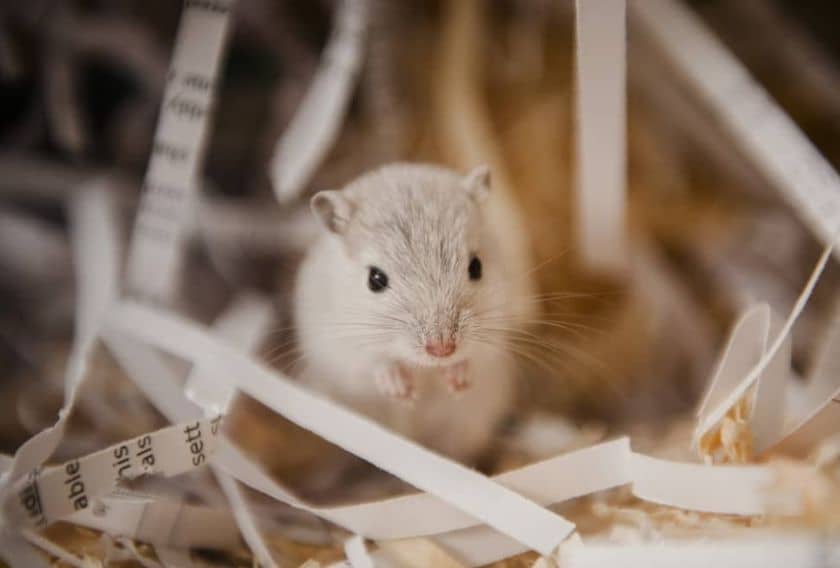Fancy Mouse, a domesticated variety of the common house mouse are popular pets known for their curious and friendly nature. The scientific name of a fancy mouse is (Mus musculus).
It is a pocket pet species artificially bred in a variety of colors and coat patterns, adding to their appeal. They come in colors of black, chocolate, blue, white, cream, lilac, fawn, cinnamon, golden agouti, silver agouti, and dove.
A large head, large eyes, tulip-shaped ears, and a long hairless tail make them distinguished creatures. The eyes are at the head’s sides, giving them a panoramic view. They are also available with different markings such as even-marked, broken-marked, banded mice, and many more. These markings on their body give them an adorable look.
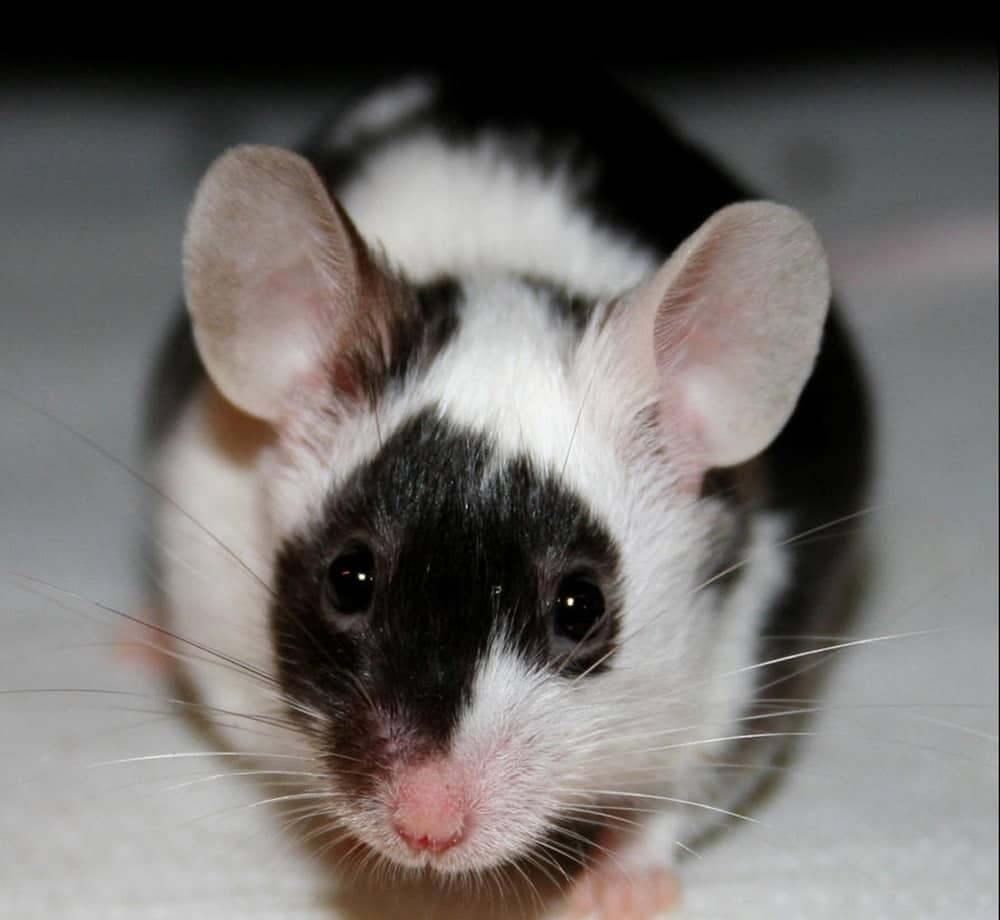
There are breeds of mouse with different coat. For example, a mouse with a standard coat has hairs which are short, straight, smooth and close to body. Moreover, some of the breeds have satin coat with higher sheen, or some have a curly or wavy haired coat. Example: Satin Texel Blue has a wavy and shiny coat of blue color
They are known for their social nature and high intelligence, mouses make delightful pets for those willing to dedicate time and effort to their care. The breeders arrange shows to display the color, body shape, and behavior of their mice.
The mice have poor eyesight therefore they use whiskers and noses as a tool to judge orientation, particularly in darkness.
These tiny creatures are lovable and relatively easy to care for, making them ideal for pet enthusiasts of all ages.
Size Information And Life Expectancy Of Fancy Mouse
Fancy Mice typically measure around 2.5 to 4 inches in body length, with a tail that is roughly the same length as their body. The mouse has a body length of nearly (5-7”) including the tail and up to 3” without a tail. They weigh between 0.5 to 1 ounce, making them one of the smallest pet rodents. The life span of a mouse is nearly 2-3 years.
Fancy Mouse Behavior and Temperament
The mouse is a highly social creature and forms close bonds with other mice and owners. They are playful and curious fellows who need social interaction to keep themselves busy. They are non-aggressive, robust, and inquisitive in nature and will hop from one point to another. They can be acclimatized to human touch and learn to sit in hand or on the shoulder with patience.
They enjoy exploring their environment, interacting with their owners, and can even learn simple tricks. These tiny creatures are voracious chewers and you need to first “mouse-proof” your house before bringing this home.
It is better to keep same-sex mice in the cage to nurture their social instincts. The female mice can happily cohabitate in groups as compared to their male counterparts.
They are fearful and need time to adapt to human contact. You should start handling them early to acclimatize them to the human touch.
What is the Difference Between a Mouse and a Rat?
Mice and rats are both rodents but there are some difference in physical attributes, characteristics and behaviors.
Mouse
Mice are generally small, with a body length (excluding the tail) of 2.5 – 4 inches (6 – 10 cm) and a tail length of 2- 4 inches (5 – 10 cm). They usually weigh between 0.5 – 1 ounce (15 -30 grams). Mice have long, thin tails covered in a light layer of hair. Mice have relatively large ears for their head size. Mice have pointed noses and small, delicate features.
They are less wary and more likely to investigate new things. Mice prefer grains and plants and are more likely to live inside buildings. Mice tend to be more solitary or live in smaller groups.
Mice typically live around 1 to 2 years in the wild. Mice reproduce quickly, with a gestation period of about 19 21 days and can have 5 10 litters per year.
Rat
Rats are larger, with a body length of 7 to 9 inches (18-23 cm) and a tail length of 6-8 inches (15-20 cm). They typically weigh 10-18 ounces (300 – 500 grams).
Rats possess thicker, shorter tails relative to their body size, which are more prominently scaled. Rats have smaller ears in proportion to their head size.Rats have broader, blunter noses and more robust features.
Rats are more cautious and neophobic (fearful of new things). They tend to be more careful in their movements and explorations. Rats are omnivorous and have a broader diet, including grains, fruits, meats, and more.
They are more likely to be found both indoors and outdoors. Rats often live in larger social groups or colonies. Rats usually live 2 to 3 years in the wild, but can live up to 4 years in captivity. Rats have a slightly longer gestation period of 21-23 days and can produce 4-6 litters per year.
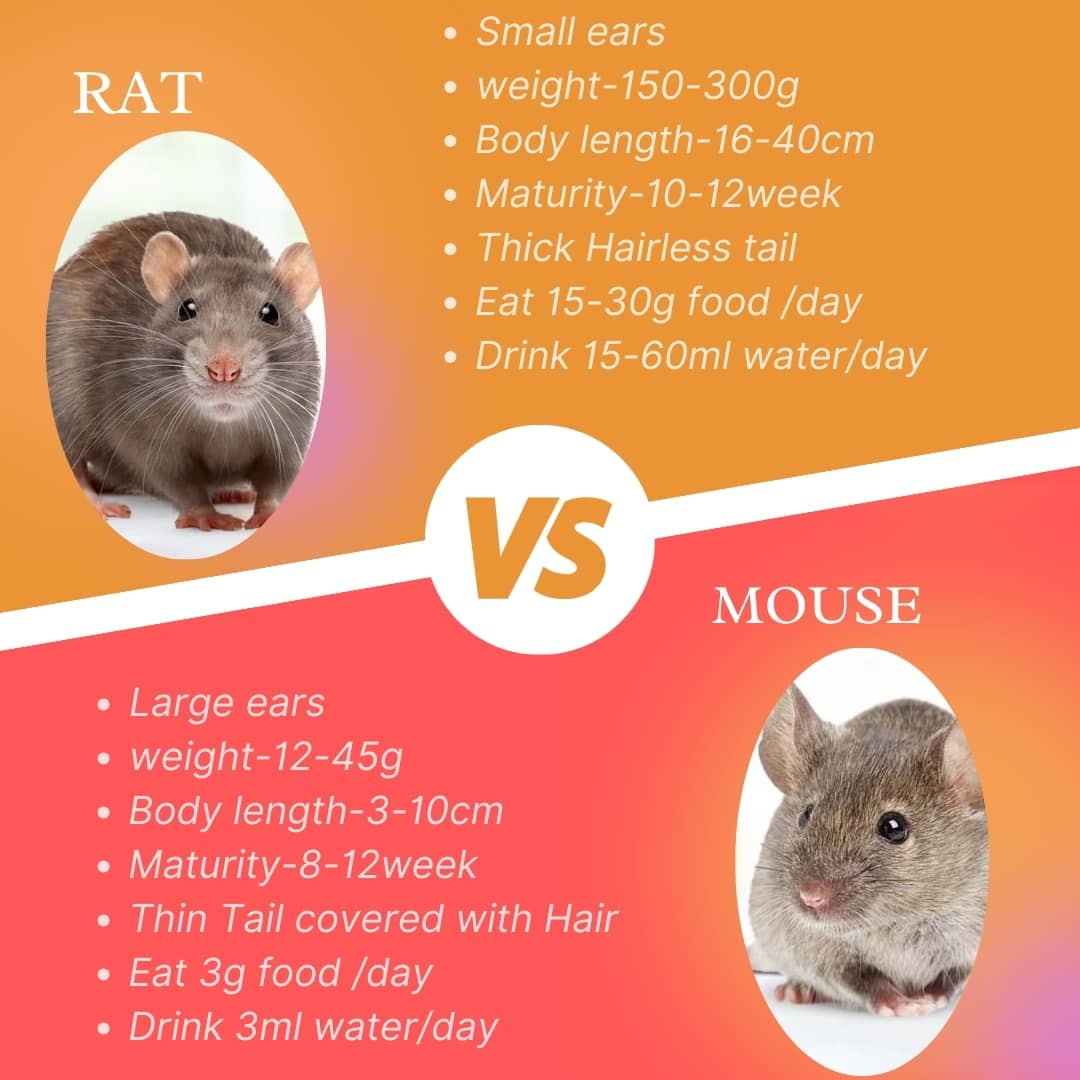
Male vs. Female Fancy Mouse
Males:
- Tend to be more territorial and may fight if housed together.
- Often have a stronger odor due to scent marking.
- Larger and sometimes more docile than females.
Females:
- Generally more social and can be housed together if introduced properly.
- Less odor compared to males.
- Smaller and more active than males.
How to Care For a Fancy Pet Mouse?
Providing proper care for mice involves ensuring that they have a stimulating environment, a balanced diet, regular exercise, and veterinary check-ups.
Housing
The mouse is an energetic creature so you should provide spacious enclosures with plenty of room for exercise and enrichment. A large wire cage with multiple levels is preferred over glass or plastic enclosures as these are poorly ventilated.
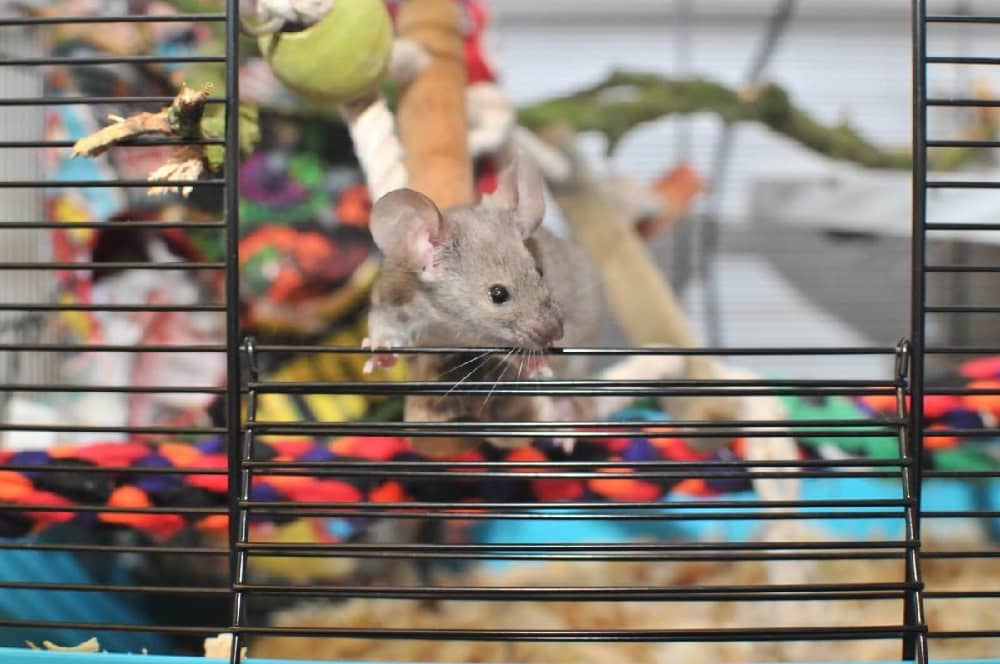
The pet mouse has a tiny body and therefore is not able to regulate body temperature easily. The solid platforms with proper bedding is ideal, along with plenty of hiding spots and chew toys.
For a mice you will also need to take height into account too. Therefore some mouse owners like to describe cage size in terms of volume i.e. gallons. Height is important because mice love to climb and dig, so if your cage isn’t high enough you can’t fit many climbing toys in and deep enough bedding.
Floor space is just as important though, so don’t be fooled thinking you can save space by just sacrificing horizontal length for more vertical height!

I personally think that 10 gallons for one mouse is way too small, and would aim (as my minimum) for at least 20 gallons for one mouse, and 10 gallons more per additional mouse.
Specific Substrate Requirements
The bedding should be deep enough to provide comfortable and cozy bedding to your mouse. There are certain points to be taken care of while setting up the bedding with a particular material. Avoid using cedar or pine shavings, as they can be toxic to their respiratory systems. Use a dust-free, absorbent substrate to maintain hygiene and reduce respiratory issues. Aspen shavings or paper-based bedding are ideal.
Nest Box
Given that mice have a strong inclination to construct their own nests due to a biological need, it is best to provide them with appropriate nesting material, such as paper tissues or recycled autoclaved paper pulp products, as opposed to enclosed plastic structures, which are not only more expensive but also require nesting material for the animals to live in them.
A small nest box of size (6”x 8”x 6”) should be set within the cage of the mouse. Good quality hay, shredded paper, tissue paper, paper towels, and cardboard are convenient choices to be used as nesting material in the nest box. You should not use cotton wool or similar bedding products as the strands of cotton get struck in their legs and pose a serious risk to their health.
Chew Toys
A mouse has overgrowing teeth, therefore you should provide chew sticks and toys for gnawing.

Exercise Wheel and Tunnel Tube
The mice love to keep themselves busy by hopping from one point to another in their cage. You can provide an exercise wheel to roll and enjoy. They explore every corner of their cage and wander through tunnels and ladders.
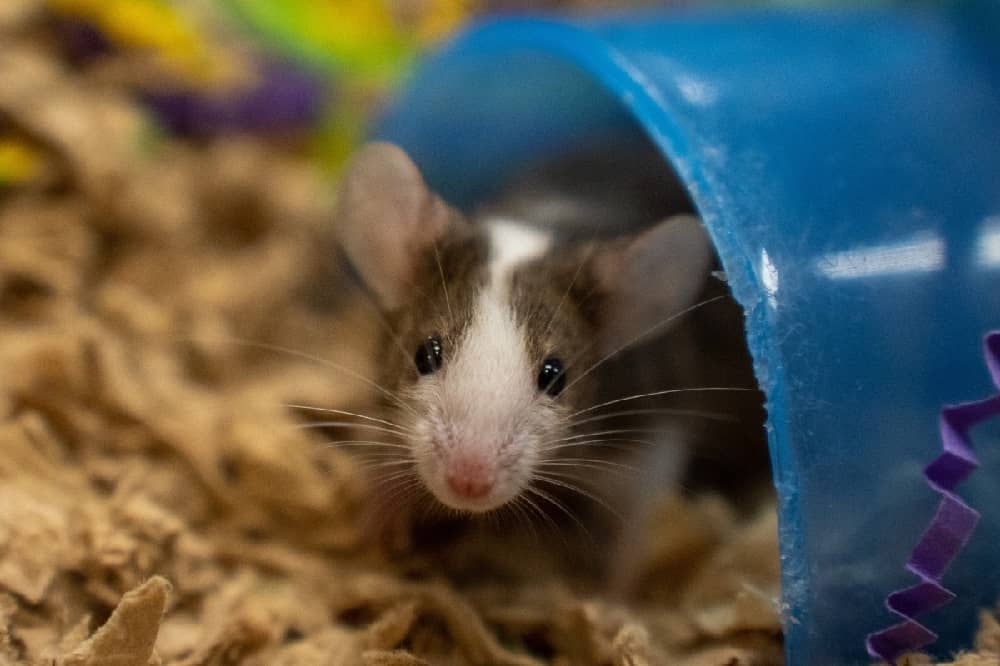
The accessories such as tunnels, wheels, and hiding places for enrichment keep your little friend happy in captivity.
Sand Bath
The mice are self-groomed living beings. You must create a small bathing zone with desert sand inside the enclosure. A designated area will be less messy and easy to clean. It helps them to stimulate their natural digging behavior.
You should use a high-sided tray, big enough for your furry friend to have a good roll in. The sand should be changed regularly.
Food Bowl and Water Bottle
A ceramic food tray and a water bottle should be kept inside the enclosure. The water bottle should have a metal tube with a chew guard.
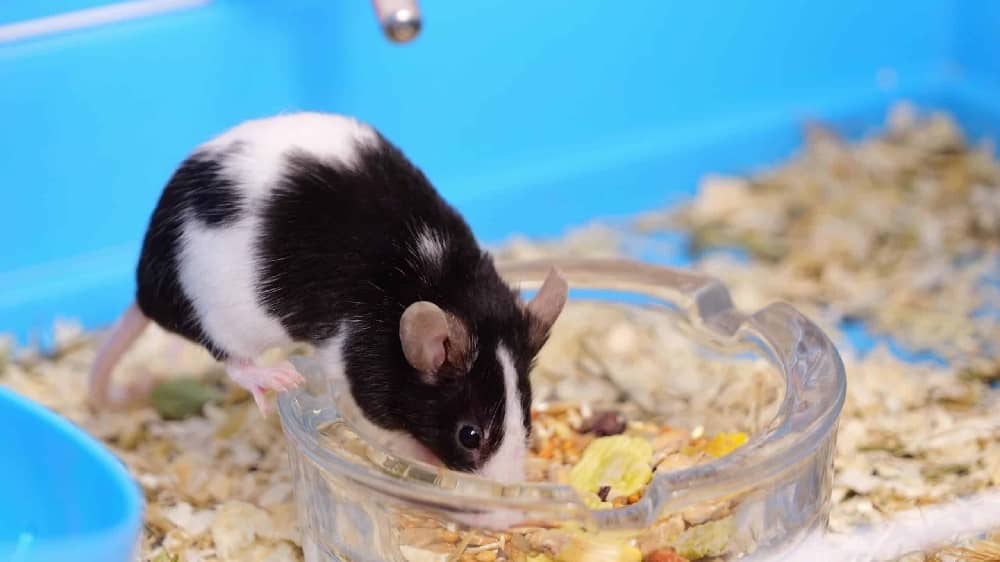
Other Points of Consideration
- It should be well-ventilated with a temperature range of nearly 20 degrees Celsius.
- You should regularly spot-clean the enclosure.
- After Cleaning put some used but unsoiled nesting and bedding material back into the enclosure so as to give them a familiar scent.
- Never house them with hamsters, gerbils, or guinea pigs as they are prone to get infections.
What Do Fancy Mouse Eat and Drink?
A mouse is an omnivore and consumes mostly wheat, oats, fruits, vegetables, grass hay, meat, and dairy products such as cheese. A balanced diet for mice consists of high-quality pellets, fresh vegetables, hay, and occasional treats such as dried fruits or nuts.
Bite-sized vegetables, bread crumbs, seeds, and eggshells give them fiber and essential nutrients. Carrots, sweet potato, beetroot, and parsnips can be given as an occasional treat. Chew tubes and mineral chews are also given to wear their overgrowing teeth.
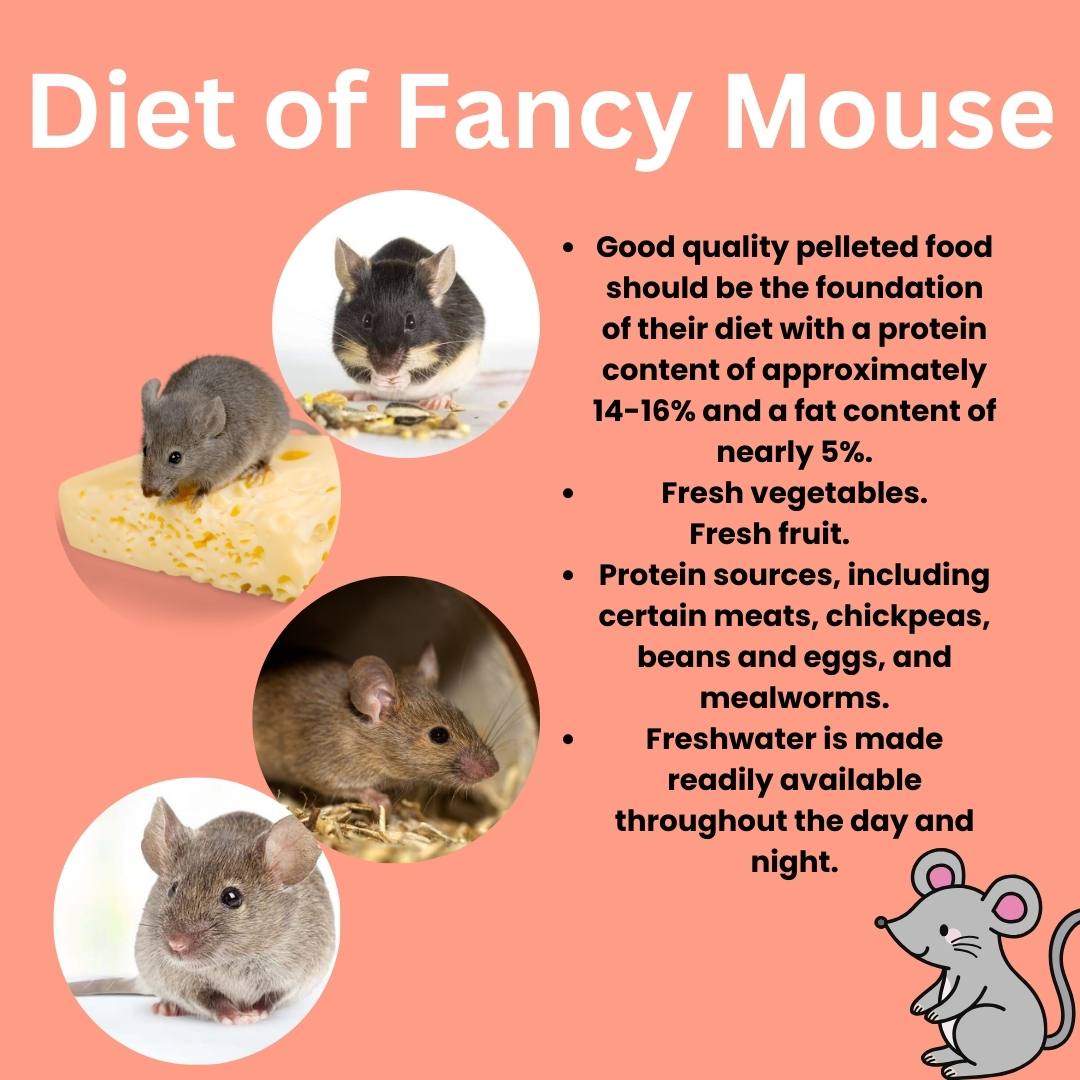
The mouse also shows coprophagy or fecal reingestion just like rabbits. It helps them to get nutrients and keep their digestive system healthy.
You should provide access to clean drinking water in a water bottle with a metal tube so that it is not chewed up by your mouse.
Handling Of a Fancy Pet Mouse
The mice can be trained to tolerate handling, but they may be initially skittish. It would be better if you start training your mouse for human contact by offering small treats on daily basis. This will help them to build trust in you.

You should always approach them calmly and avoid sudden movements. Support their body when picking them up and hold them close to your chest or on your lap, as they don’t like having their legs dangle. It is a possibility that they defecate or urinate while first being handled. Try scooping it up by cupping your hand under the mouse. Improper handling can result in biting behavior.
Common Health Problems in Pet Mouse
Common health issues in mice include dental problems, obesity, diabetes, and respiratory infections. If your mouse is alert with bright clear eyes, clean ears, glossy fur, a clean tail, and a clean anal area then these are indications of good health of your mouse.
However, if you observe some of the symptoms then you should take your mouse to the veterinarian.
- Discharge from nose
- Wetness around the mouth
- Opaque whitening of the eyes
- White teeth
The Concerned Health Issues Are
1.Mouth and Dental Problems:
Uneven incisor tooth wear, bruxism, pawing at the mouth, incapacity to gnaw, incisor tooth overgrowth (78.3%), and mobile molar teeth (4.3%) were among the clinical symptoms displayed by individual mouses who were not yet officially diagnosed.
2. Bumble Foot:
Bumble foot is a very painful condition that causes red swelling and ulcers on the bottom of the mouse’s feet.
3. Tumors:
The mice are susceptible of developing tumors in their body. Females may develop breast cancer and older mouse can suffer from leukemia and lymphoma. The reason that mice, as well as many other small animals get ill easier is due to their genomes containing more viruses.
4.Skin Condition:
Skin disorders including dry skin, which can be avoided by giving your pet mouse ,a frequent dust wash. Additionally keep a look out for pawing, trouble eating, and teary eyes. If any strange symptoms appear, get in touch with your exotics veterinarian.
5.Other problems
The overeating and lack of exercise can result in obesity, cardiovascular diseases, diabetes ,arthritis, and lethargy.
Regular veterinary check-ups and a nutritious diet can help prevent many health problems.
Exercise
Regular exercise is essential for keeping your mouse healthy and happy. You should provide opportunities for your pet to run, jump, and play outside of their cage in a safe and supervised environment. Keeping a pair of mouse is preferred over keeping a single mouse as they enjoy running behind each other. Exercise wheels and toys designed for small rodents are also great options for keeping your mouses active.
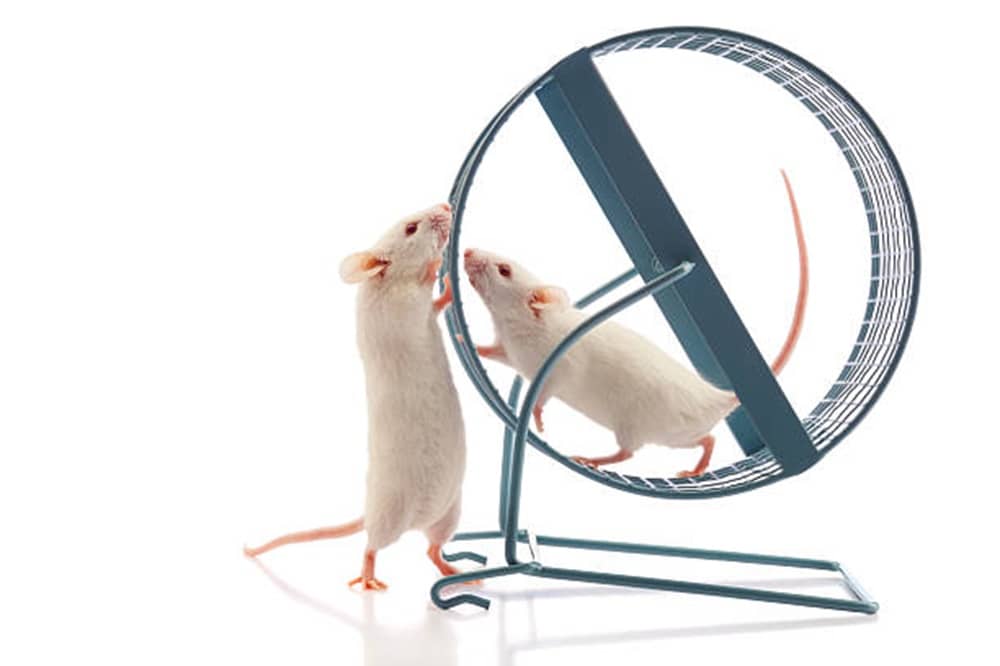
Grooming and Dental Care
The mouses do not require any special grooming. They are self-groomed and maintenance-free pets. A sand bath is a great way to keep your mouse clean entertainingly. However, if you find any dirt or debris in their paws, it can be easily cleaned with a wet wipe.
Teeth Trimming
The front teeth of mouse keep on growing therefore chewy materials like wood chews, mineral chews, and chew tubes are a must in its habitat.
Upkeep Cost
The cost of caring for a mouse includes expenses such as food, bedding, veterinary care, and occasional cage upgrades. On average, you may expect to spend around $20 to $30 per month on their upkeep.
Pros and Cons of Keeping Mouse as a Pet
Pros:
- The mice are sociable and intelligent creatures therefore they make enjoyable companions. They enjoy interacting with their human caregivers.
- As low grooming is required and diet is also not so expensive as compared to other pets like dogs or cats, therefore upkeep cost is also low.
- These can be tamed at an early age. Their fascinating behaviors and fun loving nature provide entertainment for owners. They are main attraction in some of the Mouse Shows where they showcase tricks and inquisitive nature through various activities.
Cons:
- Mice require a significant time investment for socialization and care.
- They can be prone to health problems if not provided with a proper diet and environment.
- They carry viruses and bacteria which can be transmitted to humans.
- They have a short lifespan of 2 to 3 years only.
- They are voracious chewers so you may need to make your home mouse proof especially the ,wooden furniture.

Where to Buy a Fancy Mouse?
A fancy mouse is an affordable pet that can be purchased from a reputed breeder. Its cost can vary between $5 to $10 depending on its variety.You can also adopt it from a rescue team. Before proceeding to bring it to your home, you should enquire about its gender, age, and well-being. You can also check out for getting the mouses.
- Pet-Smart : The website provides detailed information on each pet, including care instructions, habitat setup, and dietary needs. Additionally, PetSmart offers various related products such as cages, bedding, and food to ensure the well-being of your new pet. The site also highlights current deals and promotions, including options for curbside pickup and same-day delivery, making it convenient to bring home a new pet and all necessary supplies.: This online store has a wide range of healthy mouses, guinea pigs and hamsters.
Similar Pets
Frequently Asked Questions
Question 1. Are mice good pets for children?
Answer: Mice can make great pets for responsible children under adult supervision. But with younger children, you should pay more attention.
Question 2. Do mice like to be held?
Answer: They are curious creatures and can be habituated for human touch if you start holding it an early stage. With the help of intensive training using treats , some of them showcase interesting tricks.
Question 3: Can mice be litter-trained?
Answer: It is impossible to potty train these little creatures, with patience and consistency, mice can be confined to use a particular area to do their business as they use urine for scent marking.
Question 4: Do mice bite?
Answer: It is a rare phenomenon observed only when mouse is not handled properly. The stressful situations can result in biting behavior.
Question 5: Are mice rare?
Answer: No, mice are very common .These are artificially bred for pet trade, and are used in laboratory for research.
Question 6: Are mice prone to any health problems?
Answer: Mice can be prone to dental problems, diabetes, tumors , arthritis and respiratory infections if not properly cared for.
Question 7 : Can mice be housed with other small pets?
Answer: You should not keep small pets like hamster, guinea pigs and gerbil along with a mouse.
Question 8: Do mouse have smell?
Answer: Mice urinate frequently and their wee has a strong smell of musky ammonia. The smell can linger for a longer duration.
Question 9: How big do mice get?
Answer: A mouse is a small animal and get a size of nearly 10 cm.
Question 10: Are mice low maintenance?
Answer: The mice are not low maintenance as they need a continuous food supply and chewing material. These are prone to health problems, especially dental problems and need a visit to a veterinarian for trimming.
Fun Facts of Mouse
- Baby mice are born blind and deaf.
- Eyes and ears are stuck to the sides of head and eyes open at the 14th day.
- Hair grow at 2-4 days and ear opens at 3-5 days.
- Mice have an outstanding balance system in their inner ear, enabling them to balance on a narrow element such as ropes.
- They can recognize their owner’s scent and voice.
- Fancy mouse communicate through ultrasonic sounds inaudible to humans.
- They have a strong sense of smell and hearing.
- They are excellent jumpers, capable of leaping up to a foot in height.
- Fancy Mice are descendants of wild mice domesticated in China over 1,000 years ago.
- They can show empathy towards each other, particularly in social groups.
- These little creatures are used in scientific research due to their genetic similarities to humans.
- They have a lifespan of 1.5 to 3 years.
- Their teeth never stop growing, requiring them to gnaw regularly.
- They can be trained to show some tricks with the help of treats.
- They can squeeze through any space big enough for their heads.


